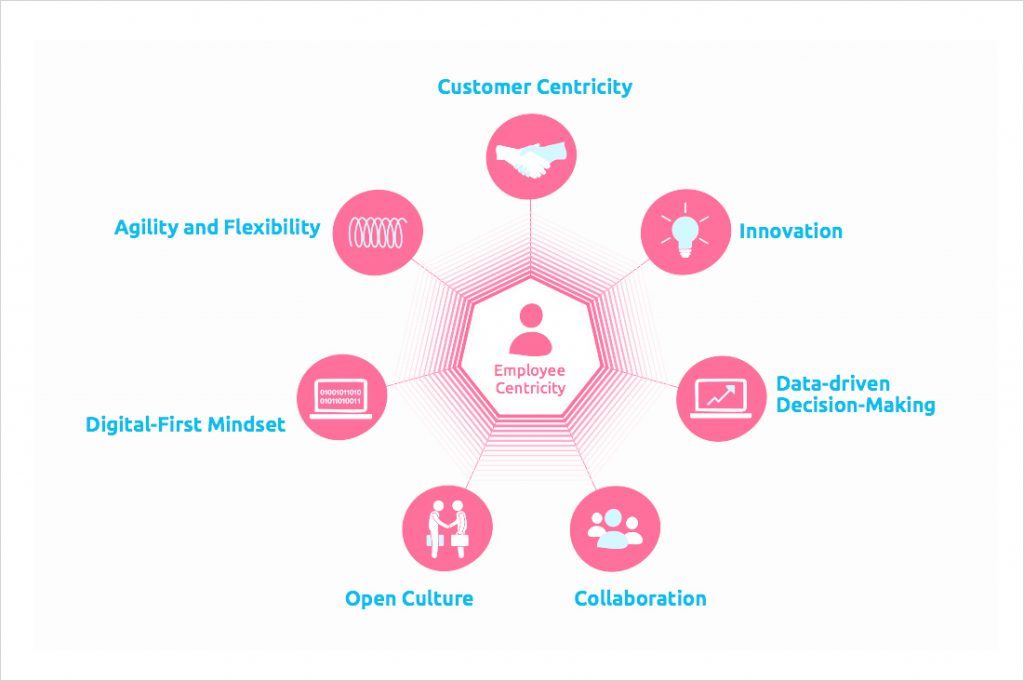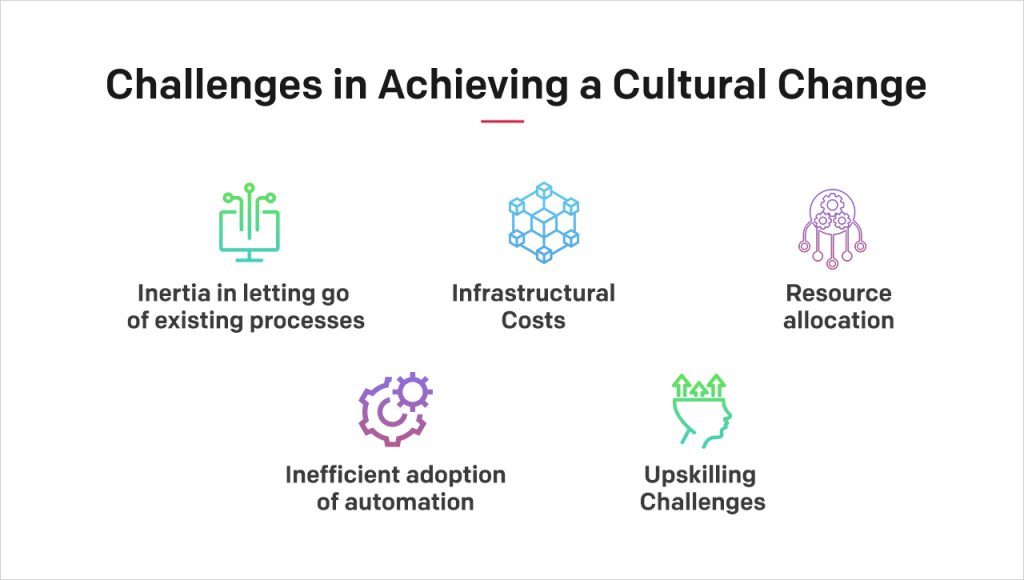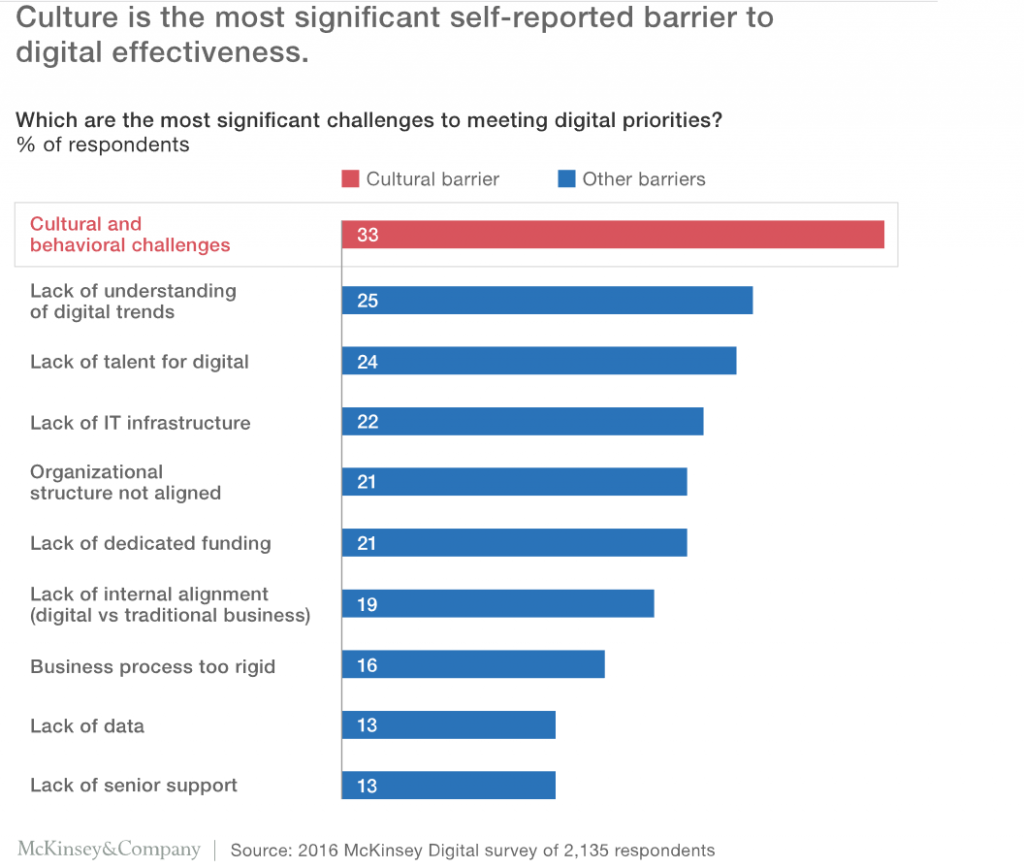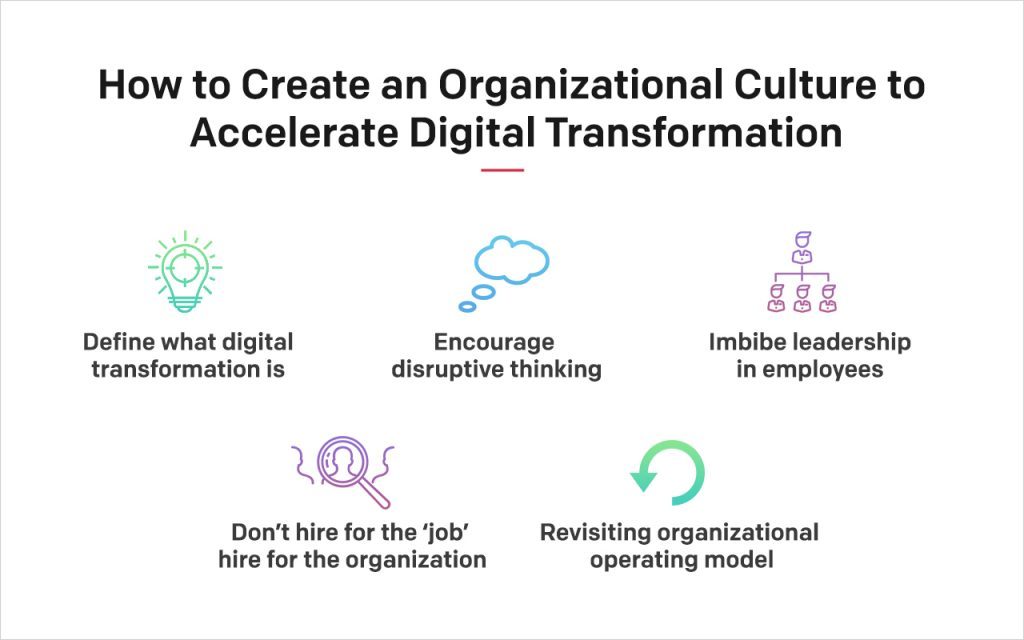Digital transformation is reshaping every industry and enterprises are finding ways to adapt to the rapidly changing business environment. Business leaders have acknowledged that organizational culture is one of the key aspects of driving business success. In a recent Deloitte study, 82% of the CEO’s and HR leaders agreed that culture drives competitive advantage.
No wonder prudent enterprises are going beyond integrating newer technologies to adapt to this new reality – they are revamping their organizational culture to digitally transform. Take for example the case of the Economist Group. The publishing business has always focussed on selling advertising space on its print and digital medium as a revenue source. However, digitization has lead publishing houses to offer integrated marketing solutions including customized content, events, etc. This new market demand requires enterprises to not just have the technologies to meet the needs of the new-age customers, but also a trained workforce to implement them. The Economist Group realized that for adapting to these demands, they will have to retrain the workforce and support them in working more collaboratively.
This approach was no longer about selling individual products for short-term it was about consulting and helping businesses and building long-term relations with the clients. To achieve the same, the company introduced its ‘’Fast Forward’’ initiative aimed not just at the sales team but also the support teams like finance, programme managers, event organisers, etc. The program included a learning-based platform with a UI similar to social media platforms and also had elements of Gamification to make the process engaging and encourage the employees to complete the training. The process involved everyone from the top management to the executives.
According to Michael Thomas, training director, the Economist Group–
“The program really pushed people to work collaboratively and to build relationships across different functional parts of the business. So we had sales working with events and finance and programme managers – it was very successful.”
An organization, in a digital transformation world, isn’t just a set of digital processes but also includes the work culture and the set of practices and attitudes that are key to implement digital transformation and succeed in a digital world.
So far, digital transformation has been about inculcating consumer-facing technologies or operational processes at some level but organizational culture is an aspect that is given the least importance when it comes to crafting a digital transformation strategy for any enterprise.
According to this study – almost 94% of the business executives equate “digital” mainly with technology, and only a small fraction that is, 6% defined it as “going beyond technology alone to reflect a mindset that embraces constant innovation, flat decision-making, and the integration of technology into all phases of the business.”
But why is it critical to include cultural transformation as an important, rather one of the most important aspects of an enterprise’s digital transformation strategy?
Here’s what Rob Roy the Chief Digital Officer at Sprint, said about how adding the ‘people factor’ to their digital transformation strategy, steered their journey in the right direction –
‘’We started using the phrase ‘digital transformation’, migrated processes and tools to be more digital, and created a dedicated business unit, and thought we’d automatically see that transformation happen. For example, we decided to do more sales online. When we set it up, we then tried to force customers down the digital path. But many of them weren’t ready. The spirit of what we were doing was correct, but a complete understanding of what we were trying to do wasn’t there. After six months, we learned that just because you say it, it doesn’t make it so. A digital transformation isn’t about digitizing a channel or simply doing more things digitally. It’s a much broader scope than that. We’re really looking to improve and simplify customer “moments of truth”—and all the supporting processes that build a true omnichannel, world-class experience. We’re now working with each area in the business to help everyone think and act digitally for the things they control. And we’re starting to see real gains in productivity, simplification, cost reduction, and building on earlier gains focused on sales.’’
The above example substantiates the fact that digital transformation will not happen in a company where the culture is not in place. However, on a positive note, business leaders realize this gap. In a Capgemini survey, 62% of the executives agreed that organizational culture is one of the biggest hurdle impeding the progress of digital transformation.
So what Exactly is a ‘Digital Culture’?
Company culture inculcates a range of attributes from a company ’s day-to-day operational processes to collective experiences and value system of the employees, leadership’s role, vision, etc. A digital culture has a different approach to all of these attributes vs a company which isn’t digitally matured. According to a report by MIT and Capgemini, digital culture comprises of the following attributes.

Image Source
- Customer Centricity: digitally matured enterprises look at everything from the customer’s perspective, their processes, internal and external, are geared up for simplifying customer journeys across every touch point.
- Innovation: a digital culture supports calculative risk-taking, go beyond standard processes and adopt disruptive technologies in order to explore newer ideas.
- Data-driven Decision-Making: the use of data and analytics to make better business decisions.
- Collaboration: a digital culture, is collaborative and encourages the creation of cross-functional, inter-departmental teams to optimize processes and increase efficiency.
- Open Culture: a digital culture reaches out for partnerships wherever necessary, instead of trying to do everything in-house.
- Digital First Mindset: a digital culture works on a mindset where digital solutions are the default way forward.
- Agility and Flexibility: a digital culture instils speed and dynamism in decision-making and accelerates the ability of the organization to adapt to changing demands and technologies.
As stated by TN Hari, Human Resources Head at Big Basket (a leading online grocery platform of India)
”In today’s digital world, it is imperative for organizations to adopt advanced technologies to improve efficiency and remain competitive. However, every organization will be having their own digital requirements and hence their own unique digital transformation journey. To bring change and align the organization for digital transformation, it will be important for business leaders to identify what kind of digital transformation their organization needs and the outcomes, even more important will be communicating this to their teams and aligning them to the vision of the organization.”
Challenges in Achieving a Cultural Change
By now we have established that digital transformation requires a cultural turn-around for any enterprise and it can be an uphill task to reshape the set processes, attitudes, behaviours and practices to adapt to the new digital reality and the challenges can be many and intimidating.
Here are some challenges that business leaders might face while revamping their organizational culture for the digital world:

1. Inertia in letting go of existing processes and culture
According to an HBR study – one of the most baffling problems which business executives face is employee resistance to change. An enterprise built on traditional and rigid processes and culture will naturally be averse to change because sticking to old processes is easier for employees than starting from scratch.
As pointed out by Professor Deborah Ancona MIT Sloan School of Management –
“Employees will resist because they still see the old behaviours as critical to their success and central to who they are while seeing the new norms as risky.”
Precisely why they continue to stick to their good old ways, and in the process, lose sight of the new envisioned goals and values of the business. However, in a digital world where technology is an integral part of people’s life, it is easier to establish the benefits of adopting newer technologies, if communicated in the right manner; and this onus lies on the business leaders.
As TN Hari, rightly puts it across
‘’We are reaping the benefits of digitization in our day-to-day lives. People are already accustomed to using technology to simplify their personal lives and they understand how it can ease their routine and mundane tasks. Then why will they not look at digitization from a similar perspective in their work lives? To bring about change, it will be critical for business leaders to show their teams, what’s in it for them? How technology will help them improve their efficiency and accelerate their progress in the organization.’’
2. Infrastructural costs
Driving a digital culture is not just a human thing, rather it needs a full-fledged infrastructure in place. This infrastructure, unlike the traditional IT systems, has much more than some hardware and legacy software platforms. It requires a range of things including products, mobile applications, social, cloud, data analytics and automation, all this can mean a huge cost to the enterprise and hence acts as an impediment.
3. Resource allocation
Adding new digital processes introduces a slew of newer tasks to the workflow of an organization. With newer operational tasks being added, there is a need for allocation of resources who can tactfully navigate through the newer processes. However, at times enterprises are not geared up to scale their resource allocation within that time frame, and that makes digital transformation difficult.
4. Inefficient adoption of automation
A digital culture focuses highly on automation. Which means moving away from the manual processes. Most people comfortable in a traditional culture are reluctant to let go of the manual processes that they have been using for decades and are always iffy about breaking off their comfort shells and adapting automation. And thereby, even when infrastructural processes are in place, automation is not effectively implemented in the enterprise.
5. Upskilling challenges
Digital literacy amongst the employees is one of the major roadblocks when it comes to instilling a digital culture. For employees used to traditional processes, it will require proper planning of a training module to incorporate digital competencies in them, which can be a challenging task. Businesses will need to invest heavily in organizing training sessions and mentorship programs to ensure success.
How to Create an Organizational Culture to Accelerate Digital Transformation
According to a study by Mckinsey, culture is the number one barrier when it comes to digital transformation.

Image Source
As complex it might sound to solve this part of the puzzle, planning ahead with the right strategy will ensure success for enterprises while getting ready for a digital future.
Here’s is how business leaders can lead the way for instilling a digital culture in their enterprises:

1. Define what digital transformation means for your organization
In broader terms, digital transformation might mean adopting technologies to improve efficiency and simplifying lives for your customers. But, every enterprise is at a different stage when it comes to their digital transformation journey, and hence individual organizations will have their own definition. It is imperative to know where your organization stands, and where do you want to reach and why.
It is important to identify answers to these questions and even more important is articulating it to your team and aligning them to the bigger picture. So that they don’t see technology as a threat or inconvenience, they see the bigger picture and technology as an ally to reach there, together.
2. Encourage disruptive thinking
Technology is disrupting industries and turning norms on their head. In a scenario like this, if your team keeps doing things the way they did or thinking the way they did, the organization will remain where it was albeit with the implementation of some digital platforms. For your team to appreciate a digital culture business leaders should reward disruptive thinking, ability to take calculated risks and even creative failures.
3. Imbibe leadership characteristics in employees
Change is never easy, thus it requires dynamic leaders to lead the way and bring change. Leaving this task to just to the C-suite of the organization will only delay the progress. Business leaders should identify leaders across functions to lead the way. Organizations can encourage leadership characteristics by creating opportunities for employees. For instance, a North American financial institution that was undergoing a digital transformation made it a practice to rotate meeting leaders, which empowered a wider variety of people in meetings. Enterprises should encourage leaders to become mentors to their team or encourage action.
Breeding leaders will need decision makers to give independence to their teams and let them make choices and decisions and feel safe while doing so. For instance, to signal change at Cisco, executives in certain divisions gave up their offices, so the company could create team rooms; the company also started allowing employees to choose the workspace and tech tools that best fit their individual roles.
3. Don’t hire for the ‘job’ hire for the organization
In a digital world where technologies change every fortnight, it is rather short-sighted to hire candidates for a ‘specific job’. Digitally mature organizations allow employees to wear multiple hats. Thus, hiring for a specific skill or tech speciality will leave you holding a lot of outdated talent. Instead, businesses should list down the qualities that will lead to a bigger, stronger, forward-thinking organization. Prudent leaders should work toward creating a workforce that will move your company and digital culture forwards.
4. Revisiting organizational operating model
In most organizations, a change in culture is first run as a pilot with the senior executives of the company. If the pilot is successful it is then rolled out to the company. However, the drawback of this approach is the traits of the executives with whom the pilot is conducted and approved, do not exist in the broader organization. The approach that applies to a mid-level manager may not work for the intern. Hence, there is a mismatch in the motivation levels within the organization to adapt to the new culture. To bridge this gap it is important that organizations re-look at their basic operating models, review systems, etc. New practices need to be implemented basis the context of the various organizational functions. Rolling out a generic strategy might not work. For instance, while embedding a digital culture, Adobe Systems abolished its annual performance management reviews, replacing them with real-time “feed forward” sessions that focus on upcoming goals.
In another example, leaders at a life sciences company reviewed their company’s “DNA statement” to ensure that the principles and the company’s systems supported the new digital culture.
In Conclusion:
As rightly pointed out by Ian Rogers, Chief Digital Officer at LVMH –
“The big moment for an organization is when they have embraced the fact that digital transformation isn’t a technical issue, but a cultural change.”
To reshape your organization’s culture and making it digital ready will require business leaders to think beyond the realms of technology. Dig deeper into their employee attitudes, organizational processes and not shy away from reshaping and altering whatever is necessary to accelerate their digital transformation journey.





